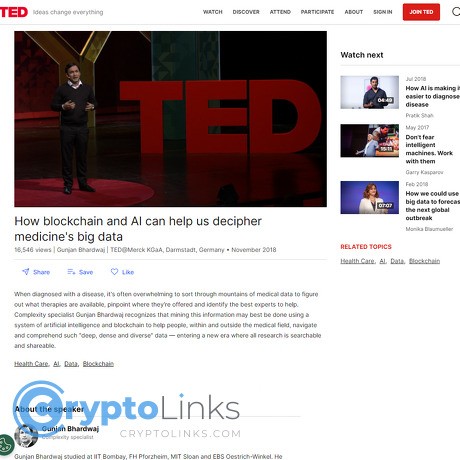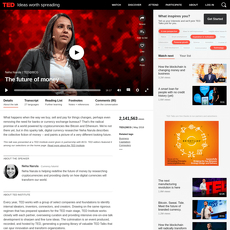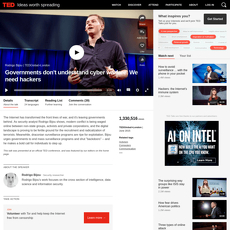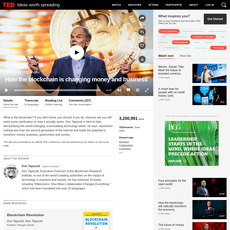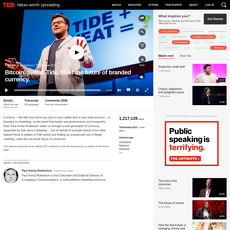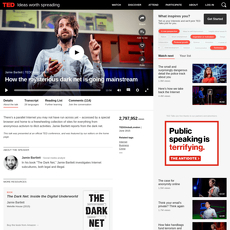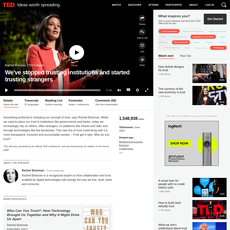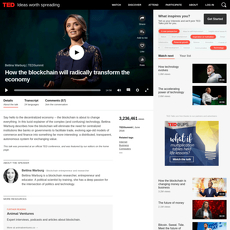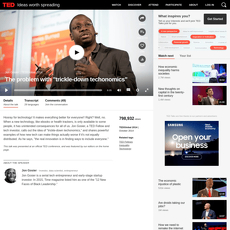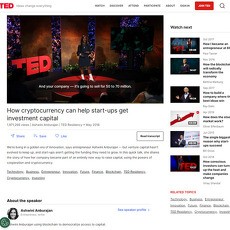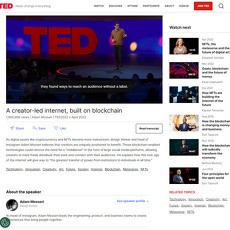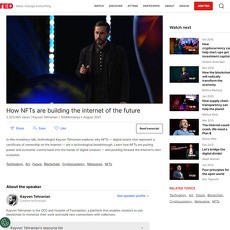Gunjan Bhardwaj: How blockchain and AI can help us decipher medicine's big data Review
Gunjan Bhardwaj: How blockchain and AI can help us decipher medicine's big data
www.ted.com
Gunjan Bhardwaj TED Talk Review: How Blockchain + AI Can Finally Make Sense of Medicine’s Big Data [Guide + FAQ]
Ever wonder why we still wait months for clinical insights when oceans of medical data are sitting in EHRs, registries, trials, and wearables right now?
That frustration is exactly why I wanted to watch—and unpack—Gunjan Bhardwaj’s TED Talk on using blockchain and AI to finally make sense of medicine’s messy data problem. If you care about crypto with real-world impact, or you’re building in health tech, this matters. The thesis is simple: get trustworthy data with clear lineage and consent; then let AI connect the dots for faster, safer decisions.
My goal here is to give you the signal, not the noise: what’s broken, what the talk offers, and what to watch next. I’ll keep it practical, with real examples and links where helpful.
The problems slowing down medicine’s data revolution
Healthcare doesn’t lack data—it lacks usable data. Here are the biggest blockers the talk spotlights (and that I see across projects):
- Data silos and mismatched formats: Hospitals, labs, CROs, pharma, and device makers all collect data differently. Even with standards like FHIR, implementation is uneven, and “interoperable” often means “a costly integration project.”
- Low trust and unclear lineage: Teams struggle to answer basic questions like: Who created this dataset? When was it updated? What transformations were applied? Without provenance, you get questionable evidence and slow audits.
- Manual, error-prone workflows: Extracting and cleaning data often involves spreadsheets, email chains, and copy-paste rituals that don’t scale. It’s no surprise timelines slip from weeks to quarters.
- Misaligned incentives: Why should a hospital or patient share if they don’t see clear value? Without transparent rewards tied to data quality, the best data stays locked away.
- Privacy and compliance minefield: Between HIPAA, GDPR, and country-by-country rules, it’s risky to share—even for good reasons. Teams over-restrict to stay safe, which slows research.
- No shared framework for quality, consent, and usage: Everyone talks governance, but few projects can prove—quickly—who accessed what, under which consent, and whether the data met agreed standards.
“If you can’t trace what data was used, under which consent, and how it changed before the result—you can’t trust the result.”
There’s plenty of evidence that this status quo is expensive and unsafe. Healthcare data is largely unstructured (think clinician notes and PDFs), a known bottleneck for discovery. Regulators are also asking for real-world evidence with transparent methodology. Without traceable, consistent data, it’s tough to meet that bar or reproduce findings.
What I promise you’ll get from this guide
- A clear, practical summary of Bhardwaj’s TED Talk—no fluff
- How blockchain and AI actually fit together (and where they don’t)
- What’s realistic vs hype—for builders, researchers, and investors
- A simple way to spot opportunities and risks in this space
I’ll keep it grounded with real examples like consent tracking, audit trails, and knowledge graphs—plus where projects typically stall (interoperability and incentives).
Why this matters to crypto and health right now
We’re finally at a point where crypto tools can make measurable improvements in healthcare workflows—if we use them right:
- Blockchain: verifiable audit trails, consent tracking, and the ability to anchor policies and updates without exposing raw patient data.
- AI: once data is linked and trustworthy, NLP and graph-based methods can spot patterns faster—safety signals, drug repurposing candidates, and more tailored options for patients.
- Together: reduce waste, speed up discovery, and make data sharing actually worth it for patients, hospitals, and researchers. The combo is “trust + insight,” not one or the other.
Think of it as upgrading healthcare’s data plumbing: clean inputs, traceable flows, and intelligent outputs—built for auditors, clinicians, and scientists, not just dashboards.
Who is Gunjan Bhardwaj and why listen?
Gunjan Bhardwaj is a life sciences tech entrepreneur known for applying knowledge graphs and AI to real-world evidence. His perspective is refreshingly practical: less theory, more “here’s how to make messy data useful and trustworthy.” If you’re tired of slick model demos with no governance, this talk is the opposite—it’s about making evidence traceable first, then running AI on top.
If you’ve ever asked, “Okay, but what does the system actually record, and how do we trust it across organizations?”—you’ll appreciate his approach.
Ready to get specific? Next up, I’m breaking down exactly what the talk says—blockchain’s job, AI’s job, and how knowledge graphs glue it together. Want the simple blueprint that makes medical data findable, interoperable, and usable at scale?
What the TED Talk actually says (no fluff)
I watched this talk and kept repeating to myself: we don’t have a data problem—we have a trust and context problem. The message is simple: use blockchain to make medical data traceable and permissioned, use AI to connect the dots across sources, and use knowledge graphs as the frame that makes everything findable and usable at scale.
“Data without trust is noise. Data with context becomes care.”
Here’s the straight-up, practical breakdown.
Blockchain’s role: provenance, consent, and incentives
Think of blockchain as the memory of the healthcare data ecosystem—the part that never forgets who contributed what, when, under which terms. It’s not about putting raw patient info on-chain. It’s about creating a verifiable trail so data can be trusted, reused, and rewarded responsibly.
- Provenance that sticks: Every dataset, model input, and update gets a unique, tamper-evident footprint. That means when a safety signal or insight appears, you can trace it back to its sources.
- Consent that travels with data: Consent is not a checkbox; it’s living metadata. The ledger records current permissions and versions, so researchers don’t have to guess if they’re allowed to use a dataset for a new question.
- Aligned incentives: If high-quality data leads to useful results, contributors can be recognized and rewarded. That could be hospitals meeting quality thresholds, or patient groups enabling ethically governed research.
Real-world signals this works aren’t hypothetical:
- National-scale integrity: Estonia’s health system uses blockchain-style integrity proofs to secure medical records and detect tampering in real time (e-Estonia).
- Pharma-grade traceability: The MediLedger project proved how a shared ledger can coordinate provenance across pharma players—useful for data lineage too, not just drugs.
- Academic permissioning: MIT’s MedRec showed how blockchains can track medical record access and patient permissions across providers.
Bottom line: without a shared, tamper-evident trail for provenance and consent, you can’t scale responsible data sharing. With it, the ecosystem starts to cooperate.
AI’s role: turning linked data into insights
AI shines once the data is linked and trustworthy. In healthcare, that means connecting research papers, clinician notes, trial registries, genomics, and real-world outcomes—then asking questions that matter for patients.
- NLP makes the unreadable usable: Models pull entities and relationships (drugs, genes, phenotypes, outcomes) out of messy text, so knowledge stops living only in PDFs and progress notes.
- Graph-aware reasoning: Once data is linked, AI can spot patterns across the network—like adverse events that only pop up in certain subgroups, or existing drugs that might work in a new indication.
- Faster signal-finding: Linked evidence shortens the path from “hunch” to “testable hypothesis,” especially for drug repurposing and safety monitoring.
This isn’t sci‑fi. We’ve seen strong proof points:
- Drug repurposing with structured linkage: The Hetionet project integrated 29 biomedical resources into one network and successfully prioritized repurposing candidates, recovering known therapies and elevating new ones (Hetionet / Project Rephetio).
- Real-world safety at scale: The FDA’s Sentinel Initiative links large datasets to detect safety signals faster than traditional methods—exactly the kind of “linked evidence” world AI thrives in.
- Entity extraction for clinicians: Tooling like SciSpacy and clinical transformers has shown real gains in extracting conditions, medications, and outcomes from unstructured notes, powering phenotyping and cohort discovery.
AI turns the lights on—but only when the wiring (provenance, permissions, linkages) is solid.
Knowledge graphs: the glue between both worlds
Knowledge graphs are the map. They stitch together patients, genes, targets, drugs, trials, labs, comorbidities—plus the evidence that links them. Then two things happen: blockchain secures the “who/when/permission” for each edge in that graph, and AI reasons across those edges to surface what matters.
- Context-rich queries: Instead of keyword search, you can ask: “Which patients with BRCA1 variants had poor outcomes on therapy X, and what alternative pathways look promising?” The graph actually understands the relationships.
- Explainable paths: AI can show the chain of evidence behind a suggestion—papers, cohorts, signals—so clinicians aren’t forced to trust a black box.
- Continuously updated knowledge: New evidence slots into the graph without breaking everything else, because entities and relationships are versioned and traceable.
Again, this approach has traction in the wild:
- Target–disease evidence at scale: Open Targets integrates literature, genetics, and clinical data into a searchable graph used by pharma and researchers to prioritize targets.
- National graph-building: NIH’s Biomedical Data Translator project is literally building a cross-domain knowledge graph to answer multi-hop clinical questions across heterogeneous data.
When you put it all together, the stack looks like this: blockchain keeps the audit trail and consent current, knowledge graphs keep the data connected and interpretable, and AI works on that connected fabric to find signals you can actually act on.
So here’s the tension I know you’re already thinking about: if the ledger remembers everything, how do we keep sensitive data private and still give regulators a clean audit trail? Exactly the right question—and it’s where things get practical fast. Keep reading next, because I’ll show you how consent stays on-chain while raw data stays protected off-chain, and why that’s the real unlock for HIPAA/GDPR-grade healthcare data sharing.
How blockchain fits healthcare data without breaking privacy laws
Let’s keep it real: no one wants their medical history floating around the internet to train a mystery model. At the same time, we all want faster insights, safer drugs, and fewer duplicated tests. The trick is building a system where data can be trusted, tracked, and used—without ever exposing raw patient information. That’s where the blockchain + AI combo starts to make sense.
“In healthcare, privacy isn’t a checkbox—it’s patient safety.”
Consent on-chain, data off-chain
The safest path is simple to explain and hard to execute well: keep raw patient data where it already lives (hospital vaults, secure research environments), and record consent, data fingerprints, and policies on-chain. That way, we get a verifiable history without leaking sensitive info.
- What lives on-chain: cryptographic hashes of datasets or model inputs, timestamps, purpose-of-use policies, consent states, and the IDs of authorized data processors. No raw PHI.
- What stays off-chain: EHR records, medical images, genomics, clinician notes, and the actual analytics outputs containing PHI.
- How access works: a patient or proxy provides consent (think Verifiable Credential), a smart contract records terms, and the hospital system grants time-bound access via its API. Revoke consent? Flip the switch on-chain; off-chain keys and tokens are invalidated.
This pattern isn’t theory-only. Estonia’s national e-health system uses blockchain-like integrity proofs to ensure medical records can’t be silently tampered with—proving “who changed what, when” without exposing contents (e-Estonia, Guardtime). MIT’s early MedRec project demonstrated on-chain access logs for patient-controlled permissions.
On the compliance side, the design addresses the “right to be forgotten” problem in GDPR by removing off-chain data and revoking keys; the remaining on-chain hashes are non-identifying fingerprints when properly salted. Regulators care about outcomes: data minimization, revocability, and accountability—all feasible with this split-architecture. For anonymization and identifiability risks, the UK ICO offers straight-shooting guidance on when data is truly anonymous vs. re-identifiable (ICO).
When analysis is needed without moving PHI, bring compute to the data. Approaches like compute-to-data let models run inside the hospital’s secure environment while only sharing approved outputs (Ocean Protocol). Add privacy tech—trusted execution environments (Intel SGX), differential privacy (OpenDP), or even policy proofs using zero-knowledge techniques—and you get strong guardrails without killing utility.
Tokenized incentives for data quality and sharing
Data sharing fails when incentives fail. If good actors get the same reward as bad data dumpers, quality drops and trust evaporates. Tokenized systems can change that—pay only when quality criteria are met, and make those criteria machine-checkable.
- Quality gates: smart contracts release rewards only after validators confirm basics like FHIR compliance, de-duplication, completeness of fields (SNOMED/RxNorm codes present), and up-to-date consent.
- Reputation and slashing: contributors with repeated errors or policy violations lose stake or reputation; high-quality contributors earn higher weight and better pricing.
- Compute bounties: instead of selling raw data, hospitals and patients get paid when a model runs successfully against their consented dataset and passes post-run checks (e.g., no leakage of identifiers, results within agreed scope).
We’ve seen the mechanics in the wild. Data token models and on-prem compute flows are already shipping in Web3 tooling (Ocean), while pharma consortia like PharmaLedger show how shared infrastructure and rules reduce friction across competitors. The lesson is consistent: reward validated contributions, not just bulk uploads.
Auditability that regulators can understand
Healthcare runs on audits. If your system can’t explain itself to a regulator, it won’t last. Immutable logs make that explanation faster and safer.
- End-to-end lineage: every access, transform, and model run gets a signed, timestamped entry. That’s gold for HIPAA, ICH-GCP, and 21 CFR Part 11 electronic records requirements (FDA, ICH).
- Human-readable reports: you don’t hand an inspector a block explorer. You generate a clean report with cryptographic anchors they can verify if needed.
- Proven track record: during COVID-19, the UK used Hedera to attest vaccine cold-chain telemetry in hospitals—showing regulators trust tamper-evident logs when the stakes are high (Hedera x Everyware). For pharma, the MediLedger pilots under DSCSA illustrated how immutable records help with compliance and recalls.
For AI-specific scrutiny, you can pin data cards, model cards, and versioned training sets to on-chain references. That makes “why did the model say that?” a question you can answer—not a liability.
Interoperability and standards
If systems don’t speak the same language, nothing moves. The fix is boring and essential: commit to standards and make them discoverable on-chain.
- FHIR-first: use HL7 FHIR R4 resources with consistent vocabularies like SNOMED CT, LOINC, RxNorm, and ICD-10. Most major EHRs now expose SMART on FHIR APIs thanks to the ONC Cures Act (ONC).
- Registries you can trust: put schema versions, code system mappings, and dataset identifiers into an on-chain registry. That gives everyone a single source of truth for “which version of FHIR?” or “which SNOMED release?”
- Roles and credentials: represent identities and permissions with Decentralized Identifiers (DIDs) and Verifiable Credentials. Pair that with OAuth2/UMA 2.0 for consent-aware access control between orgs (Kantara UMA).
Put it together and you get a healthcare data backbone that’s traceable, privacy-preserving, and actually usable—for hospitals, researchers, and patients. Now here’s the fun part: what happens when you point modern NLP and graph-based AI at this clean, consent-aware foundation? Think faster signal detection, safer decisions, and fewer dead ends. Ready to see how that stack works end-to-end?
The AI stack that makes medical big data actually useful
AI only works when data is cleaned, linked, and explained. Here’s the practical stack I see winning in healthcare—fast, safe, and actually usable by clinicians and regulators.
“In medicine, the model you can’t explain is the insight you can’t use.”
NLP for the unstructured mess
Most medical knowledge lives in PDFs, clinician notes, trial registries, and safety reports. That’s raw gold—if you can turn it into structured facts without breaking privacy.
What solid NLP looks like in healthcare:
- De-identification to strip names, dates, and IDs
- Entity extraction mapped to real vocabularies: UMLS, SNOMED CT, RxNorm, ICD-10
- Negation and temporality so “no fever” and “history of MI in 2018” don’t get misread
- Relation extraction that links “drug → dose → adverse event” or “gene → variant → phenotype”
Real examples worth your time:
- Apache cTAKES is a workhorse for clinical NLP in hospitals.
- Bio/ClinicalBERT adapts transformers to clinical text and helps with phenotyping and risk prediction.
Bottom line: if your NLP doesn’t map to medical ontologies and track what changed, when, and why, your downstream models will be guessing in the dark.
Knowledge graphs for reasoning
Once facts are extracted, they need context. Knowledge graphs connect patients, drugs, genes, trials, and outcomes so we can ask “why” and “what if,” not just “what.”
What a healthcare graph should capture:
- Entities: patients, conditions, biomarkers, targets, interventions, outcomes
- Relationships: “treats,” “inhibits,” “associated_with,” “contraindicated_in,” with timestamps and evidence
- Provenance: every node/edge carries source, method, and version so you can audit and update
Proof it works in the wild:
- Hetionet (eLife) combined 29 datasets into a single graph and successfully ranked drug repurposing candidates, recovering known therapies and surfacing new hypotheses.
- Open Targets uses an integrated evidence graph to link genes to diseases and prioritize drug targets used by pharma teams.
- NCATS Biomedical Data Translator builds reasoning graphs across diverse biomedical sources to answer complex clinical queries.
Tech note: RDF/OWL or property graphs both work. What matters is consistent IDs, good ontologies, and versioned edges with citations that your compliance team won’t hate.
Real-world evidence at speed
Linking real-world data (EHRs, claims, registries) with trial data can turn months of manual reconciliation into hours—and surface safety and effectiveness signals earlier.
Why this is already changing decisions:
- Label expansions with RWE: The FDA expanded palbociclib (Ibrance) to male breast cancer using EHR/registry evidence—no new randomized trial required. Source: FDA press release.
- Networked pharmacovigilance: The FDA Sentinel Initiative runs distributed queries across partner data to monitor post-market safety without centralizing patient records.
- Standards that unlock scale: The OMOP Common Data Model (OHDSI) normalizes vocabularies so multi-site studies run consistently.
- Trial emulation: Target-trial frameworks help avoid bias when mimicking RCTs with observational data (Hernán & Robins, AJE).
Pair this with a lineage-first mindset: every cohort definition, code list, and feature transform gets a version ID and a cryptographic anchor so results can be reproduced, audited, or rolled back.
Guardrails against bias and hallucinations
No one wants a black-box telling a clinician what to prescribe—especially not for your kid. Guardrails make AI trustworthy and keep regulators on your side.
- Lineage-aware datasets: Dataset versions and source hashes (anchored on-chain) so you can explain any prediction down to the note, claim, or lab value used.
- Bias and performance audits: Evaluate by subgroup (age, sex, ancestry, site). Calibrate probabilities and document limits with Model Cards and Datasheets for Datasets.
- Retrieval-augmented generation (RAG): Force LLMs to cite evidence from your graph/EHR index. No citation, no answer.
- Uncertainty you can use: Conformal prediction adds “I’m not sure” bands for high-stakes cases (intro paper).
- Traceable re-training: When data drifts or labels update, re-train with full audit of what changed and why. The provenance trail makes approvals smoother.
Put simply: facts flow from NLP, context lives in the graph, speed comes from RWE pipelines, and trust is earned with transparent lineage and guardrails. Want the practical checklist on what to build first—and which metrics prove it’s working? Keep going.
What this means for builders, researchers, and investors
“Patients aren’t data points; they’re people whose worst day became your dataset. Treat provenance, consent, and context like someone’s life depends on it—because it might.”
For startups and devs
Winning teams won’t chase “full decentralization.” They’ll ship consent workflows, data lineage, and dead-simple APIs hospitals can actually use.
Build the backbone first:
- Consent as a product: Implement dynamic consent with versioned policies and revocation. W3C Verifiable Credentials + DIDs let you issue, update, and prove consent without exposing PHI. Evidence from genomic research shows dynamic consent improves engagement and control (Kaye et al., 2015).
- Data off-chain, truth on-chain: Keep PHI in secured vaults and FHIR servers; anchor hashes, policies, and access events on a permissioned or privacy-preserving chain. Estonia’s national e-health uses Guardtime-style integrity anchoring to prove records weren’t tampered (e-Estonia).
- Standards or nothing: Model data in FHIR and/or OMOP, code with SNOMED CT + LOINC. On-chain registries should reference FHIR resource IDs, not raw data.
- Privacy tech that fits: Start with permissioned chains (e.g., Fabric/Quorum) or L2s with zk-proofs for auditability without leaking metadata. TEEs can help for model runs; log attestations on-chain.
API-first sample stack:
- FHIR server (EHR/claims) + secure data vault
- Consent/VC service issuing and verifying permissions
- Knowledge-graph layer mapping patients, drugs, genes, outcomes
- Ledger module for hashes, policy updates, access logs
- Analytics API that returns lineage with every result
Metrics that earn budget:
- Time-to-insight: days from IRB approval to result
- Audit time saved: hours shaved off compliance reviews via immutable logs
- Data quality: % FHIR resources validated, OMOP conformance, duplicate rate
- Consent correctness: zero violations; % of requests auto-approved by policy
Reality check from the field: MIT’s MedRec showed feasibility years ago; today’s wins come from pairing that idea with standards, consent UX, and clinical integrations—think “FHIR + VC + permissioned ledger,” not “throw it on a public chain.”
For researchers and hospitals
Pick one workflow where provenance reduces pain and show measurable value in under 90 days.
Good first pilots:
- Oncology registry linking: Connect pathology, imaging, and outcomes across sites using FHIR. On-chain consent logs prove who accessed what, when.
- Pharmacovigilance: Link EHR events with claims to flag adverse events faster; FDA’s Sentinel Initiative shows real-world signal detection works when data is linked with traceability.
- Trial cohort discovery: Use knowledge graphs to find eligible patients; keep every filter and query lineage on-chain for audit.
What to measure (and report to leadership):
- IRB-to-data-ready time (with and without automated consent verification)
- Manual reconciliation cuts (hours saved matching IDs across systems)
- Completeness (fields populated, missingness, dedup rates)
- Explainability (can you replay the exact dataset and permissions that fed a model?)
Governance you’ll actually pass:
- Data Protection Impact Assessment, role-based access, and consent revocation paths
- Immutable logs of data transforms and model inputs/outputs
- Bias checks per subgroup; publish model cards tied to provenance
One practical pattern: Hash every FHIR resource version; store hash + policy pointer on-chain. When a model runs, store the manifest (resource IDs + hashes) so regulators can reproduce results without touching PHI.
For investors and partners
Back teams who can get real data under real governance—and know how to translate that into lower costs or faster decisions.
Due diligence questions that separate signal from noise:
- Data access: Signed DUAs with hospitals? Named datasets? IRB approvals?
- Standards: FHIR/OMOP-native or proprietary schemas that won’t scale?
- Reg posture: HIPAA/GDPR counsel engaged, DPIAs complete, HITRUST/ISO/SOC roadmap?
- Consent tech: Can patients update or revoke consent? Is that auditable on-chain?
- Clinical ties: PIs, hospital champions, or pharma partners actually using it?
- Economic proof: Audit time cut by X%, cohort discovery sped up by Y days, safety signals found earlier—what’s the dollar impact?
Healthy KPIs over “token talk”:
- Number of FHIR endpoints integrated and % validated
- Median procurement cycle time at providers
- Reproducible analyses per quarter (with manifests + lineage)
- Net revenue from compliance/audit savings or RWE contracts—not just grants
Partnership tip: Incentivize quality. Offer higher payouts for datasets that pass completeness and de-dup thresholds; slash rewards for low-signal/noisy contributions. Garbage shouldn’t pay.
Red flags and reality checks
- PHI on-chain: If raw medical data is anywhere near a public ledger or IPFS, walk.
- No path to consent updates: Healthcare consent changes; systems must reflect revocation fast and provably.
- Zero interoperability plan: No FHIR/OMOP means endless custom ETL and brittle pilots.
- Incentives misaligned: Paying for volume, not quality, turns the dataset into spam.
- Opaque models: No model cards, no lineage manifests, no subgroup bias tests—expect regulatory friction.
- “We’re just a platform” defense: In healthcare, you inherit duty-of-care expectations. Governance is not optional.
Quick sniff test: If the pitch can’t show a consent ledger entry, a data manifest, and a replayable analysis in 5 minutes, it’s not ready for clinical reality.
Still wondering if it’s ever safe to touch a blockchain with medical data—or how this stacks up with HIPAA/GDPR in the real world? I’ll tackle those exact questions next, with crisp yes/no answers you can use in your next meeting.
FAQ: quick answers people ask about blockchain, AI, and this TED Talk
Is it safe to put medical data on a blockchain?
No one should put raw patient data on-chain. The safe pattern is simple: keep data off-chain in secure hospital or research environments, and put hashes, consent policies, and access logs on-chain. That way you get verifiable history without exposing PHI. This isn’t theoretical—Estonia has used Guardtime’s KSI blockchain to integrity-check national health records for years, and MIT’s MedRec prototype showed how to anchor permissions and provenance without moving clinical data itself.
Can this meet HIPAA/GDPR requirements?
Yes—if you design for it from day one. The playbook looks like this:
- Off-chain storage for PHI with strong encryption and access control
- On-chain consent references, purpose-of-use, and auditable access logs
- Data minimization and role-based access for researchers
- Revocation by cutting access keys and policies (nothing personal is stored immutably on-chain)
GDPR’s “right to be forgotten” is handled by deleting/invalidating the off-chain record and keys. The chain only keeps non-identifying proofs and policy updates for accountability.
What’s the big benefit of combining blockchain with AI?
Trust + insight. Blockchain gives provenance, consent, and auditability so you know where data came from and what it can be used for. AI turns that clean, linked data into findings you can act on—like earlier safety signals or repurposing opportunities. One famous knowledge-graph win: BenevolentAI used graph-based reasoning to flag baricitinib as a COVID-19 candidate, which later received emergency authorization. Add blockchain-grade lineage to that workflow and you strengthen the evidence chain end to end.
Any real-world examples?
- National integrity checks: Estonia’s e-health system uses KSI blockchain to make tampering visible across records.
- Clinical data lineage: MIT’s MedRec demonstrated on-chain permissions and audit trails for EHR pointers, not raw data.
- Pharma collaborations: EU initiatives like PharmaLedger have piloted blockchain for supply chain, electronic product info, and clinical processes—showing how standards and governance drive adoption.
- Trial ops: Groups like Triall have tested blockchain-backed document integrity with major health systems to cut audit overhead in clinical trials.
The common thread: keep data local and protected, make the trail public and verifiable.
Will this lower healthcare costs?
It can. Expect savings where there’s duplication and compliance friction today:
- Less reconciliation: shared provenance reduces time spent matching mismatched datasets
- Faster audits: regulators and QA teams can review immutable access and transformation logs instead of chasing PDFs
- Quicker insights: better-linked data shortens research cycles and avoids dead ends
Early pilots report shorter audit preparation and faster data onboarding. The real cost win depends on scale, data quality incentives, and governance discipline.
Where can I watch the talk?
Watch Gunjan Bhardwaj’s TED Talk here. I recommend it with a notepad—you’ll want to mark the parts on consent and knowledge graphs.
How does this compare to other “AI in health” talks?
It’s refreshingly grounded. Instead of showing flashy models, it focuses on data lineage, consent, and knowledge graphs. In real healthcare, explainability and provenance beat black-box demos every time.
What are the biggest challenges?
- Data silos and uneven incentives to share
- Interoperability across HL7 FHIR, OMOP, and hospital IT reality
- Regulatory alignment across borders (HIPAA, GDPR, local rules)
- Model bias and explainability in high-stakes clinical decisions
- Change management—getting clinicians and compliance on board
How can I get started?
Keep it tight and measurable:
- Pick one workflow with real pain (e.g., oncology outcomes registry linking labs + EHR + trial arms)
- Use privacy-aware chains (permissioned or zk-enabled) and standard schemas (FHIR IDs, OMOP CDM)
- Anchor consent events and access logs on-chain; store data in secure vaults
- Track outcomes that matter: time-to-insight, time-to-audit, and number of validated safety signals
“Good data beats big data—especially when you can prove where it came from and who can use it.”
Want the exact tools and a one-week action plan I’d use right now? I’m laying that out next—curious which chain, standards, and metrics I’d pick first?
My take: worth your time—and here’s how to use it
Short version: this talk actually respects how healthcare works. It’s not “put everything on a blockchain” or “AI will fix it.” It’s trust + context so real insights don’t take months. If you’re building, researching, or investing, this is the right mental model.
Why I think it’s worth your time: we finally have the tooling to make provenance, consent, and interoperability boring—in a good way. That unlocks faster science without gambling with privacy.
And yes, there are real examples pointing in this direction:
- System integrity at scale: Estonia’s national e-health stack has used KSI blockchain to ensure tamper-evidence for years—no raw data on-chain, just verifiable integrity signals. That’s the vibe healthcare trusts.
- Consortia that actually ship: The EU-backed PharmaLedger project delivered production-grade pilots (eLeaflet, supply chain traceability). Different problem domain, same playbook: common standards + shared audit trails.
- Explainable analytics at population scale: The FDA’s Sentinel Initiative shows what trusted, auditable real-world evidence looks like (not blockchain, but a great baseline). Pair that with blockchain provenance and you cut audit pain while keeping regulators comfortable.
- Privacy-first collaboration: Projects like OpenSAFELY proved you can run queries where the data lives, with rigorous governance. Plug on-chain consent and lineage into that pattern and you get practical, compliance-friendly shared research.
Working formula: trust the source, trace the consent, stitch the context. Insights get faster—and safer—by default.
Who should watch this
- Founders building health data tools who need a governance backbone that won’t collapse at the first audit.
- Researchers who’ve had enough of “mystery CSVs” with zero lineage and want explainable results.
- Crypto builders hunting for real utility—provable data quality and consent beats speculative tokenomics all day.
Action plan for next week
- Pick one messy workflow where provenance + consent would remove friction. Good starters: oncology registry updates, trial eligibility checks, or adverse event signal sharing.
- Lock your standards: FHIR for schemas, consistent IDs, and a permission model you can explain to a privacy officer. If you can’t map it to FHIR, expect rework.
- Prototype the right split: off-chain data vault + on-chain consent and lineage logs. Add policy hashes and access timestamps only—never raw PHI.
- Track two numbers: time-to-audit (how long to prove who touched what, when) and time-to-insight (from data arrival to a validated finding). If both don’t improve, fix the plumbing before adding AI.
If you want inspiration for the prototype, look at FHIR resources for schema, use a privacy-aware chain (or rollup) for consent logs, and wire in a basic knowledge graph to keep relationships queryable (patients → treatments → outcomes). Even a small, clean graph beats a pile of PDFs.
Final word: build where trust compounds
Healthcare doesn’t need flash—it needs clean data, clear consent, and models you can explain without a PhD. This talk lands that point. If you care about real-world crypto utility, this is fertile ground: verifiable provenance, standards-first design, and AI that earns its keep.
I’ll keep sharing the sharpest tools, lessons from live pilots, and no-nonsense picks on cryptolinks.com so you can move from idea to impact without the fluff.

